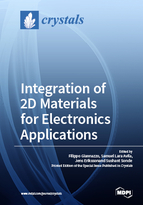Integration of 2D Materials for Electronics Applications
A special issue of Crystals (ISSN 2073-4352). This special issue belongs to the section "Inorganic Crystalline Materials".
Deadline for manuscript submissions: closed (30 November 2017) | Viewed by 124398
Special Issue Editors
Interests: 2D materials (graphene, transition metal dichalcogenides); wide-bandgap semiconductors (SiC, GaN); high-power and high-frequency electronics; electrical atomic force microscopy (C-AFM, SCM, SSRM)
Special Issues, Collections and Topics in MDPI journals
Interests: 2D materials; nanoelectronics; quantum transport in graphene
Interests: 2D materials; silicon carbide; sensors
Special Issue Information
Dear Colleagues,
Two-dimensional (2D) crystals and their vertical/lateral heterostructures are currently the subject of massive research interests, both for fundamental science and for technological applications in diverse fields, such as electronics, optoelectronics, quantum metrology, spintronics, membranes, energy conversion/storage, and sensing.
Integration of 2D materials within real device structures currently represents the main challenge to move from the laboratory stage to industrial applications, especially in the fields of electronics/optoelectronics. This implies addressing several complex material science and processing issues, including: (i) the growth of high electronic quality 2D crystals on large area, and non-destructive transfer to the target substrate, when needed; (ii) the fabrication of contacts for optimal current injection at 3D/2D materials interface; and (iii) the deposition of thin dielectric films on the chemically inert surface of Van der Waals crystals.
This Special Issue will be dedicated to discussing recent developments associated with 2D material integration for electronics applications. Contributions are invited on these topics, with special emphasis on (but not limited to):
-
Controlled synthesis of high electronic quality 2D materials (including graphene, transition metal dichalcogenides, boron nitride, phosphorene, silicene, germanene, stanene) and van der Waals heterostructures on large area.
-
Processing issues for the fabrication of devices based on 2D materials and heterostructures (contacts, dielectrics, passivation) both on conventional and flexible substrates.
-
Integration of 2D materials with conventional semiconductors for electronics/optoelectronics.
-
2D materials based devices (lateral and vertical architectures) and their applications: RF analogue, digital, sensing, etc.
-
Advanced characterisation of electronic, optical and mechanical properties.
-
Modelling of properties and devices based on 2D materials and heterostructures.
Dr. Filippo Giannazzo
Dr. Jens Erikkson
Dr. Samuel Lara Avila
Dr. Sushant Sonde
Guest Editors
Manuscript Submission Information
Manuscripts should be submitted online at www.mdpi.com by registering and logging in to this website. Once you are registered, click here to go to the submission form. Manuscripts can be submitted until the deadline. All submissions that pass pre-check are peer-reviewed. Accepted papers will be published continuously in the journal (as soon as accepted) and will be listed together on the special issue website. Research articles, review articles as well as short communications are invited. For planned papers, a title and short abstract (about 100 words) can be sent to the Editorial Office for announcement on this website.
Submitted manuscripts should not have been published previously, nor be under consideration for publication elsewhere (except conference proceedings papers). All manuscripts are thoroughly refereed through a single-blind peer-review process. A guide for authors and other relevant information for submission of manuscripts is available on the Instructions for Authors page. Crystals is an international peer-reviewed open access monthly journal published by MDPI.
Please visit the Instructions for Authors page before submitting a manuscript. The Article Processing Charge (APC) for publication in this open access journal is 2600 CHF (Swiss Francs). Submitted papers should be well formatted and use good English. Authors may use MDPI's English editing service prior to publication or during author revisions.
Keywords
-
2D materials
-
synthesis
-
advanced characterization
-
integration
-
electronics/optoelectronics applications







